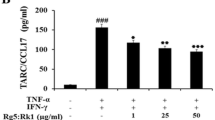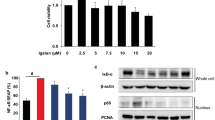Abstract
We recently reported the inhibitory effect of an oral administration of a Sophora flavescens Aiton methanol extract on the development of atopic dermatitis in the NC/Nga model mice. Heme oxygenase (HO)-1 has recently emerged as an important cytoprotective enzyme against oxidative stress and inflammatory responses in many cell types. The aim of this study was to investigate the possible mechanism by which prenylated chalcone (PC, 7,9,2′,4′-tetrahydroxy-8-isopentenyl-5-methoxychalcone), a natural product isolated from S. flavescens, inhibited cytokine-induced Th2 chemokine expression in human keratinocytes, HaCaT cells. The level of chemokine expression was measured by reverse transcription-polymerase chain reaction and HO-1 study was performed by Western blot analysis. Interferon-γ (IFN-γ) and tumor necrosis factor-α (TNF-α)-induced thymus- and activation-regulated chemokine (TARC/CCL17), macrophage-derived chemokine (MDC/CCL22), cutaneous T-cell attracting chemokine (CTACK/CCL27) expression in a dose-dependent manner. Interestingly, PC significantly suppressed IFN-γ and TNF-α-induced TARC/CCL17, MDC/CCL22 and CTACK/CCL27 expression via the induction of heme oxygenase (HO)-1. This suppression was completely restored by HO-1 siRNA, suggesting a direct role of HO-1 for the suppressive effect. Furthermore, exogenous CO, but not other end products of HO-1 activity, also suppressed IFN-γ and TNF-α-induced TARC/CCL17, MDC/CCL22 and CTACK/CCL27 expression. These results demonstrate that prenylated chalcone induces HO-1 expression, which in turn HO-1 and/or CO suppresses Th2 chemokine expressions induced by cytokines in human HaCaT cells.
Similar content being viewed by others
References
Boguniewicz, M., Schmid-Grendelmeier, P., and Leung, D. Y., Atopic dermatitis. J. Allergy Clin. Immunol., 118, 40–43 (2006).
Ding, Y., Tian, R. H., Kinjo, J., Nohara, T., and Kitagawa, I., Three new oleanene glycosides from Sophora flavescens. Chem. Pharm. Bull., 40, 2990–2994 (1992).
Fujimoto, S., Uratsuji, H., Saeki, H., Kagami, S., Tsunemi, Y., Komine, M., and Tamaki, K., CCR4 and CCR10 are expressed on epidermal keratinocytes and are involved in cutaneous immune reaction. Cytokine, 44, 172–178 (2008).
Furukawa, H., Nakamura, K., Zheng, X., Tojo, M., Oyama, N., Akiba, H., Nishibu, A., Kaneko, F., Tsunemi, Y., Saeki, H., and Tamaki, K., Enhanced TARC production by dustmite allergens and its modulation by immunosuppressive drugs in PBMCs from patients with atopic dermatitis. J. Dermatol. Sci., 35, 35–42 (2004).
Homey, B., Alenius, H., Müller, A., Soto, H., Bowman, E. P., Yuan, W., McEvoy, L., Lauerma, A. I., Assmann, T., Bünemann, E., Lehto, M., Wolff, H., Yen, D., Marxhausen, H., To, W., Sedgwick, J., Ruzicka, T., Lehmann, P., and Zlotnik, A., CCL27-CCR10 interactions regulate T cell-mediated skin inflammation. Nat. Med., 8, 157–165 (2002).
Horikawa, T., Nakayama, T., Hikita, I., Yamada, H., Fujisawa, R., Bito, T., Harada, S., Fukunaga, A., Chantry, D., Gray, P. W., Morita, A., Suzuki, R., Tezuka, T., Ichihashi, M., and Yoshie, O., IFN-γ-inducible expression of thymus and activation-regulated chemokine/CCL17 and macrophage-derived chemokine/CCL22 in epidermal keratinocytes and their roles in atopic dermatitis. Int. Immunol., 14, 767–773 (2002).
Jeong, S. I., Choi, B. M., Yun, Y. G., Lee, J. W., and Jang, S. I., A noble therapeutic approach of atopic dermatitis by development of Th2 chemokine inhibitors from natural products: inhibitory effect of Sophora flavescens extract in atopic dermatitis model mice, NC/Nga. Korean J. Orient. Med. Prescrip., 17, 141–151 (2009).
Jung, H. J., Kang, S. S., Woo, J. J., and Choi, J. S., A new lavandulylated flavonoid with free radical and ONOOscavenging activities from Sophora flavescens. Arch. Pharm. Res., 28, 1333–1336 (2005).
Kim, J. H., Ryu, Y. B., Kang, N. S., Lee, B. W., Heo, J. S., Jeong, I. Y., and Park, K. H., Glycosidase inhibitory flavonoids from Sophora flavescens. Biol. Pharm. Bull., 29, 302–305 (2006).
Kirino, M., Kirino, Y., Takeno, M., Nagashima, Y., Takahashi, K., Kobayashi, M., Murakami, S., Hirasawa, T., Ueda, A., Aihara, M., Ikezawa, Z., and Ishigatsubo, Y., Heme oxygenase 1 attenuates the development of atopic dermatitis-like lesions in mice: implications for human disease. J. Allergy Clin. Immunol., 122, 290–297 (2008).
Lee, B. S., Heo, J., Kim, Y. M., Shim, S. M., Pae, H. O., and Chung, H. T., Carbon monoxide mediates heme oxygenase 1 induction via Nrf2 activation in hepatoma cells. Biochem. Biophys. Res. Commun., 343, 965–972 (2006).
Lee, B. S., Shim, S. M., Heo, J., Pae, H. O., Seo, B. Y., Han, S. Y., Sohn, D. H., Jang, S. I., and Chung, H. T., Wogonin suppresses TARC expression induced by mite antigen via heme oxygenase 1 in human keratinocytes. Suppressive effect of wogonin on mite antigen-induced TARC expression. J. Dermatol. Sci., 46, 31–40 (2007).
Lee, J. H., Baek, N. I., Kim, S. H, Park, H. W., Yang, J. H., Lee, J. J., Kim, S. J., Jeong, S. I., Oh C. H., Lee, K. H., and Kim, D. K., A new cytotoxic prenylated chalcone from Sophora flavescens. Arch. Pharm. Res., 30, 408–411 (2007).
Leung, D. Y., Boguniewicz, M., Howell, M. D., Nomura, I., and Hamid, Q. A., New insights into atopic dermatitis. J. Clin. Invest., 113, 651–657 (2004).
Morse, D., Pischke, S. E., Zhou, Z., Davis, R. J., Flavell, R. A., Loop, T., Otterbein, S. L., Otterbein, L. E., and Choi, A. M., Suppression of inflammatory cytokine production by carbon monoxide involves the JNK pathway and AP-1. J. Biol. Chem., 278, 36993–36998 (2003).
Nakazato, J., Kishida, M., Kuroiwa, R., Fujiwara, J., Shimoda, M., and Shinomiya, N., Serum levels of Th2 chemokines, CCL17, CCL22, and CCL27, were the important markers of severity in infantile atopic dermatitis. Pediatr. Allergy Immunol., 19, 605–613 (2008).
Otterbein, L. E., Soares, M. P., Yamashita, K., and Bach, F. H., Heme oxygenase-1: unleashing the protective properties of heme. Trends Immunol., 24, 449–455 (2003).
Pae, H. O., Choi, B. M., Oh, G. S., Lee, M. S., Ryu, D. G., Rhew, H. Y., Kim, Y. M., and Chung, H. T., Roles of heme oxygenase-1 in the antiproliferative and antiapoptotic effects of nitric oxide on Jurkat T cells. Mol. Pharmacol., 66, 122–128 (2004).
Pivarcsi, A. and Homey, B., Chemokine networks in atopic dermatitis: traffic signals of disease. Curr. Allergy Asthma Rep., 5, 284–290 (2005).
Rao, G. V., Swamy, B. N., Chandregowda, V., and Reddy, G. C., Synthesis of (+/−) abyssinone I and related compounds: Their anti-oxidant and cytotoxic activities. Eur. J. Med. Chem., 44, 2239–2245 (2009).
Sebastiani, S., Denelon, G., Gerber, B., and Uguccioni, M., CCL22 induced responses are powerfully enhanced by synergy inducing chemokines via CCR4: evidence for the involvement of b strand of chemokine. Eur. J. Immunol., 35, 746–756 (2005).
Soler, D., Humphreys, T. L., Spinola, S. M., and Campbell, J. J., CCR4 versus CCR10 in human cutaneous TH lymphocyte trafficking. Blood, 101, 1677–1682 (2003).
Song, J. Z., Xu, H. X., Tian, S. J., and But, P. P., Determination of quinolizidine alkaloids in traditional Chinese herbal drugs by nonaqueous capillary electrophoresis. J. Chromatogr. A., 857, 303–311 (1999).
Sumiyoshi, K., Nakao, A., Setoguchi, Y., Tsuboi, R., Okumura, K., and Ogawa, H., TGF-β/Smad signaling inhibits IFN-γ and TNF-α-induced TARC (CCL17) production in HaCaT cells. J. Dermatol. Sci., 31, 53–58 (2003).
Tsukahara, H., Shibata, R., Ohshima, Y., Todoroki, Y., Sato, S., Ohta, N., Hiraoka, M., Yoshida, A., Nishima, S., and Mayumi, M., Oxidative stress and altered antioxidant defenses in children with acute exacerbation of atopic dermatitis. Life Sci., 72, 2509–2516 (2003).
Vestergaard, C., Johansen, C., Christensen, U., Just, H., Hohwy, T., and Deleuran, M., TARC augments TNF-α-induced CTACK production in keratinocytes. Exp. Dermatol., 13, 551–557 (2004).
Vestergaard, C., Bang, K., Gesser, B., Yoneyama, H., Matsushima, K., and Larsen, C. G., A Th2 chemokine, TARC, produced by keratinocytes may recruit CLA+CCR4+ lymphocytes into lesional atopic dermatitis skin. J. Invest. Dermatol., 115, 640–646 (2000).
Vestergaard, C., Yoneyama, H., Murai, M., Nakamura, K., Tamaki, K., Terashima, Y., Imai, T., Yoshie, O., Irimura, T., Mizutani, H., and Matsushima K. Overproduction of Th2-specific chemokines in NC/Nga mice exhibiting atopic dermatitis-like lesions. J. Clin. Invest., 104, 1097–1105 (1999).
Weston, W. L. and Howe, W., Epidemiology, clinical manifestations, and diagnosis of atopic dermatitis (eczema). UpToDate 2007. Available at: http://www.uptodate.com. Accessed June 16 (2008).
Wu, L. and Wang, R., Carbon monoxide: endogenous production, physiological functions, and pharmacological applications. Pharmacol. Rev., 57, 585–630 (2005).
Xiao, T., Kagami, S., Saeki, H., Sugaya, M., Kakinuma, T., Fujita, H, Yano, S., Mitsui, H., Torii, H., Komine, M., Asahina, A., Nakamura, K, and Tamaki, K., Both IL-4 and IL-13 inhibit the TNF-α and IFN-γ enhanced MDC production in a human keratinocyte cell line, HaCaT cells. J. Dermatol. Sci., 31, 111–117 (2003).
Zhu, Y. P., Chinese Materia Medica. Harwood Academic Publishers, Amsterdam, pp. 149–155, (1998).
Zuckerbraun, B. S., Billiar, T. R., Otterbein, S. L., Kim, P. K., Liu, F., Choi, A. M., Bach, F. H., and Otterbein, L. E., Carbon monoxide protects against liver failure through nitric oxide-induced heme oxygenase 1. J. Exp. Med., 198, 1707–1716 (2003).
Author information
Authors and Affiliations
Corresponding authors
Rights and permissions
About this article
Cite this article
Choi, BM., Oh, GS., Lee, J.W. et al. Prenylated chalcone from Sophora flavescens suppresses Th2 chemokine expression induced by cytokines via heme oxygenase-1 in human keratinocytes. Arch. Pharm. Res. 33, 753–760 (2010). https://doi.org/10.1007/s12272-010-0515-8
Received:
Revised:
Accepted:
Published:
Issue Date:
DOI: https://doi.org/10.1007/s12272-010-0515-8




